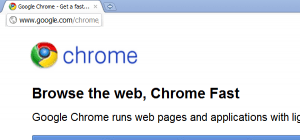
As browser wars continue to heat up, Google Chrome finds itself trailing IE9 in one of its most compelling attributes – viewable web and application space. It’s a “less is more” world as speed and ease are replacing components and functionality for many (thus, the reduced market share for Firefox).
To combat this, Google is considering several different options for a future Chrome browser that includes eliminating the URL bar altogether. This is currently the leading concept on the table, narrowly edging the sidebar design because of the incompatibilities with certain website types and hardware.
Described by Google as a “compact navigation” model, it would eliminate the two line navigation layout. Currently, Chrome has tabs on top and the navigation buttons, menu and URL bar below.
According to Wolfgang Gruener at ConceivablyTech, “The compact navigation model would only have one line and place the navigation buttons, a search button, tabs and menus next to each other. The URL bar is gone and the URL of each tab is not visible at all times, but only displayed when a page is loading and when a tab is selected. In effect, there are now multiple URL bars that are integrated into tabs.”
Chrome continues to gain on Firefox and Internet Explorer. Its reputation (and associated ad campaigns) for speed and ease of use is appealing to an ever-growing segment that wants browsers that move quickly and load pages fast. Throw in the additional web and app real estate and Chrome may be poised to move up a position (or two) sometime in 2012.

